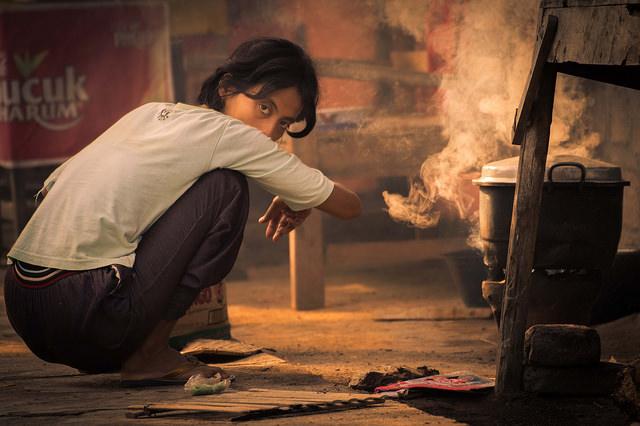Indonesia’s troubled quest for food self-sufficiency
Posted By John McBeth on December 19, 2016 @ 12:30

Indonesia’s failing drive for food self-sufficiency, which began under the government of Susilo Bambang Yudhoyono, is costing domestic consumers tens of billions of dollars and has led to the highest rice prices in the Southeast Asian region.
Recent research by the Organisation for Economic Co-operation and Development [1] (OECD) found Indonesians were ‘taxed’ the equivalent of US$98 billion between 2013 and 2015 as a result of import restrictions and government market and agricultural interventions. Last year alone, the cost was estimated at US$36 billion, compared with the US$22 billion levied on consumers across the 28-nation European Union, whose long-standing agricultural policies have never been kind to shoppers.
October’s World Bank quarterly report [2] says that translates into a per capita tax of US$1,300, compared with US$437 in the EU and just US$189 in Vietnam, where the rice price is the lowest in the region at US$300 a tonne—compared with Indonesia’s US$800 a tonne. Just as startling is that prices of goods ranging from eggs and honey to chicken, carrots, mangoes and oranges is between 25–50% higher in Jakarta than in Singapore, which imports nearly all its food.
Indonesia’s single-minded focus on self-sufficiency stems from the danger climate change is seen to present to its food supply over the next three decades, evidenced this year by a supposed dry season that wasn’t. The rain simply hasn’t stopped. While the climate debate has degenerated into an ideological fist-fight in the United States and other parts of the Western world, Indonesia feels it can’t afford to ignore the threat as it comes to terms with dramatic transformations in land use and increasingly variable weather patterns.
But in trying to attain self-sufficiency in a range of food staples, the Government has so far struggled to equate policy goals based on questionable data with the marketplace realities of supply and demand and, just as importantly, changing diets.
While Food and Agriculture Organisation figures show that targeted commodities like rice and maize have tenuously kept pace with demand through much of the past decade, sugar, soybeans and beef are still woefully short of the mark.
Under the Yudhoyono administration, agricultural policies were incoherent and largely driven by politically-inspired nationalist urges—as evidenced by the doomed efforts to sharply reduce, and even end, cattle and beef imports from Australia. Passed in Yudhoyono’s second term, the 2012 Food Law [3] laid down core objectives, which included minimising the country’s reliance on imported staples and achieving what Yudhoyono’s successor, Joko Widodo, calls ‘food sovereignty.’
Under that concept, coined in the 1990s, those who produce, distribute, and consume food should control the mechanisms and policies of food production, rather than the corporations and market institutions who dominate the global food supply.
While Indonesia’s total support for agriculture is proportionately the highest and fastest growing among OECD nations, most of that spending has gone on fertilizer subsidies and other inputs. Very little has gone towards research, infrastructure and advisory services vital for increased productivity and competitiveness.
Widodo started out wanting to achieve rice self-sufficiency by 2017 [4] with plans to rehabilitate one million hectares of irrigated paddy fields and raise the government’s rice purchasing price by 10%, to Rp 7,260 per kg.
But with the 2015 market price of milled rice 68% higher than it would be without protective measures, self-sufficiency is very different from achieving food security, where everyone has access to food to meet their needs for proper nutrition.
The World Bank [2] says that food security policies have had their biggest impact on the poor and contributed to high rates of stunted growth. ‘Indonesia’s nutritional status,’ it notes, ‘is more akin to a low income country than a rapidly growing and urbanizing middle-income country.’ It’s estimated that Indonesians at the lowest end of the social scale spend 61% of their household income on food, a third of that on rice alone, which explains why Indonesia is still the world’s largest per capita consumer of the staple.
More than that, restrictions on rice, maize and sugar imports and various non-tariff measures applied to animal and horticultural products may have afforded some protection from competition, but that hasn’t translated into higher prices for farmers.
Indonesia’s food concerns go back to 1997–98 when droughts induced by a particularly severe El Nino weather phenomena caused massive crop failures [5], water shortages and devastating forest fires across Sumatra and Kalimantan.
But it wasn’t until Indonesia took over from crisis-hit Thailand as the host of the 2007 United Nations Climate Change Conference that it was forced into a learning curve which included not only the environment, but all aspects of a subject it hadn’t thought much about. The next year, a huge spike in food prices provided Indonesia with more evidence of its vulnerability, encouraging the government to devise a National Climate Master Plan that focused on food security and the need to remove food crops from planned biofuel production.
The latest World Bank quarterly report doesn’t address climate concerns, but it says an urbanising middle class Indonesia needs a more balanced policy, taking it away from a dominant focus on rice production and towards a more modern food system.
Former trade officials are highly critical of the Agriculture Ministry, in particular, for failing to improve its data collection and presenting successive governments with a false picture of the food situation. But ultimately the buck stops with President Widodo, who could soon find himself under political attack for clinging stubbornly to goals which are impossible to meet.
Article printed from The Strategist: https://aspistrategist.ru
URL to article: /indonesias-troubled-quest-food-self-sufficiency/
URLs in this post:
[1] Organisation for Economic Co-operation and Development: http://www.oecd.org/tad/agricultural-policies/agriculture-policy-monitoring-flyer-2016.pdf
[2] World Bank quarterly report: http://www.worldbank.org/en/country/indonesia/publication/indonesia-economic-quarterly-october-2016
[3] 2012 Food Law: http://pdf.usaid.gov/pdf_docs/pbaaa173.pdf
[4] rice self-sufficiency by 2017: http://www.thejakartapost.com/news/2015/01/31/indonesia-aiming-food-self-sufficiency-three-years.html
[5] massive crop failures: http://www.fao.org/faostat/en/#country/101
Click here to print.